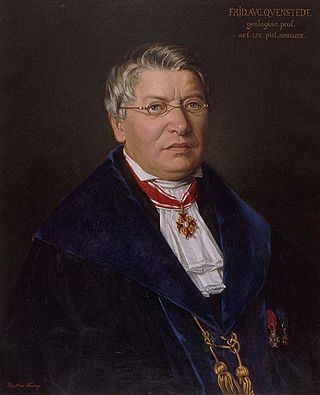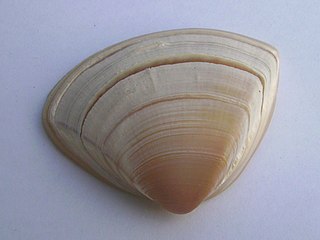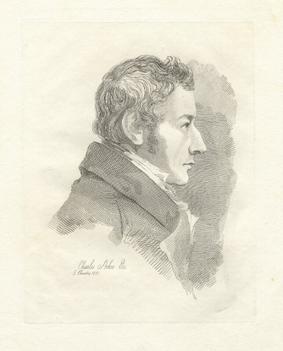Related Research Articles

The Wollaston Medal is a scientific award for geology, the highest award granted by the Geological Society of London.

John Phillips FRS was an English geologist. In 1841 he published the first global geologic time scale based on the correlation of fossils in rock strata, thereby helping to standardize terminology including the term Mesozoic, which he invented.

Friedrich August von Quenstedt was a German geologist and palaeontologist.

Muricidae is a large and varied taxonomic family of small to large predatory sea snails, marine gastropod mollusks, commonly known as murex snails or rock snails. With over 1,700 living species, the Muricidae represent almost 10% of the Neogastropoda. Additionally, 1,200 fossil species have been recognized. Numerous subfamilies are recognized, although experts disagree about the subfamily divisions and the definitions of the genera. Many muricids have unusual shells which are considered attractive by shell collectors and by interior designers.

Thomas Davidson was a British palaeontologist.
Searles Valentine Wood was an English palaeontologist.

Wilfred Hudleston Hudleston was an English geologist, ornithologist and paleontologist.

Palaeocoma is an extinct genus of brittle stars that lived during the Middle Triassic to Early Jurassic Periods. Its fossils have been found in Europe.

Crassula aequilatera, known as the triangle shell, is a surf clam, a moderately large marine bivalve mollusc in the family Mactridae.

(Pierre Joseph) Auguste Bravard was a French mining engineer turned palaeontologist. He hunted fossils in the Vaucluse, Allier and his native Puy de Dôme.
Leslie Reginald Cox FRS was an English palaeontologist and malacologist.

Leonard Charles Wyon was a British engraver of the Victorian era most notable for his work on the gold and silver coinage struck for the Golden Jubilee of Queen Victoria in 1887 and the bronze coinage of 1860 with the second ("bun") head portrait, in use from 1860 to 1894.

Harpa amouretta, common name the lesser harp, is a species of sea snail, a marine gastropod mollusk in the family Harpidae, the harp snails.

Periglypta is a genus of bivalves in the subfamily Venerinae of the family Veneridae.

Oscar Friedrich von Fraas was a German clergyman, paleontologist and geologist. He was the father of geologist Eberhard Fraas (1862–1915).
Helen Marguerite Muir-Wood was a British paleontologist and historian of paleontology who spent her career at London's Natural History Museum. She is a recipient of the prestigious Lyell Medal for her contributions to the field.

Charles Stokes was a London stockbroker who gained a reputation both as an amateur scientist and as an art collector.
Wheelton Hind was an English surgeon and geologist.
References
- ↑ "Lyell Medal". The Geological Society of London. Retrieved 2022-05-16.
- Hugh S. Torrens and Michael A. Taylor Collections, collectors and museums of note No. 55 Geological collectors and museums in Cheltenham 1810-1988 A case history and its lessons Geological Curator, Vol.5, No.5, 1990 (for 1988), pp. 175–213 online pdf
- Lambrecht W, Quenstedt W, Quenstedt A. (1938) Palaeontologi: Catalogus bio-bibliographicus. Fossilium Catalogus I: Animalia 72: 1–495. [reprinted 1978, Arno Press, New York]
- Cleevely R.J. (1983) World palaeontological collections. British Museum (Natural History) and Mansell, London, 365 pp.